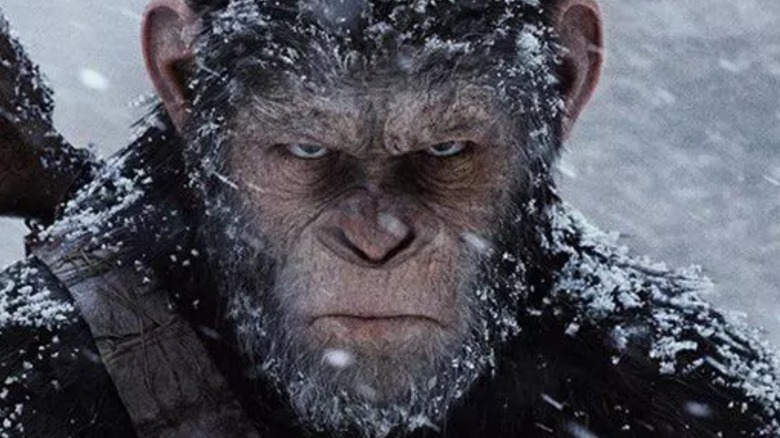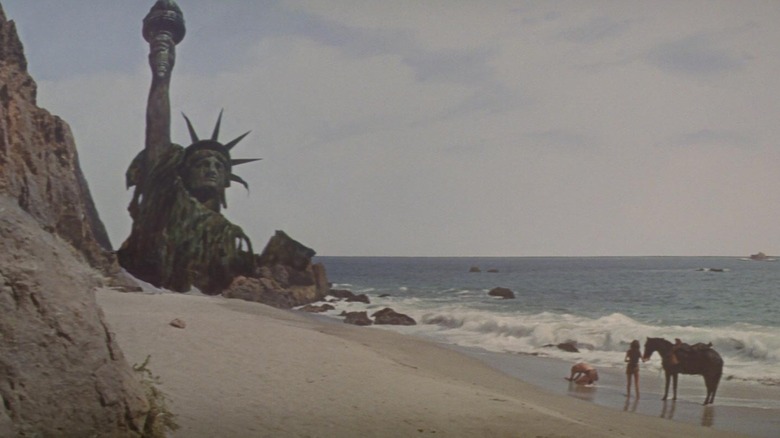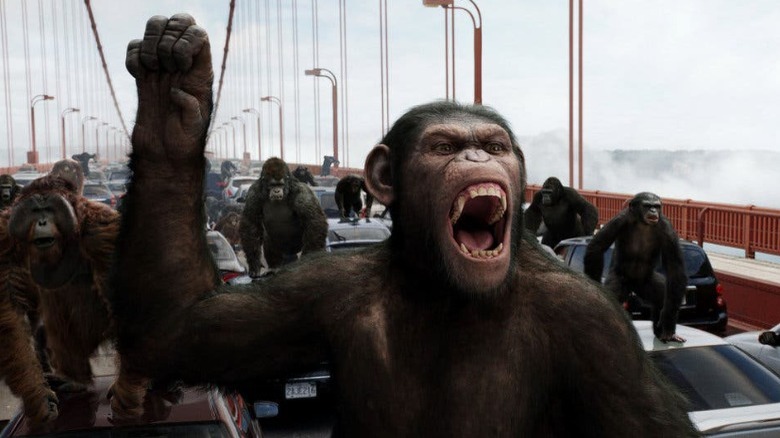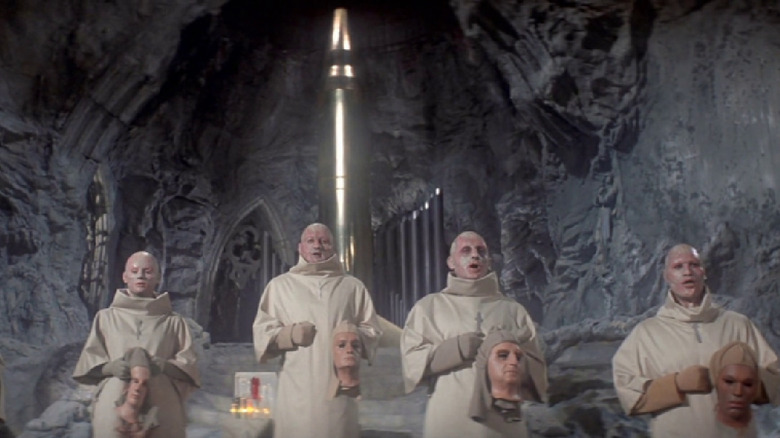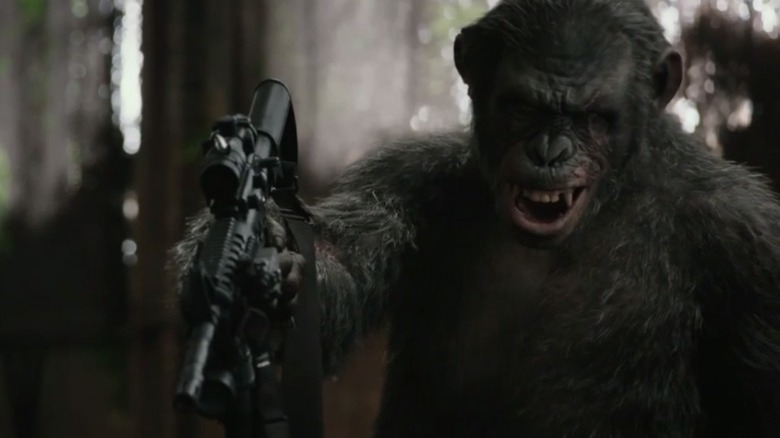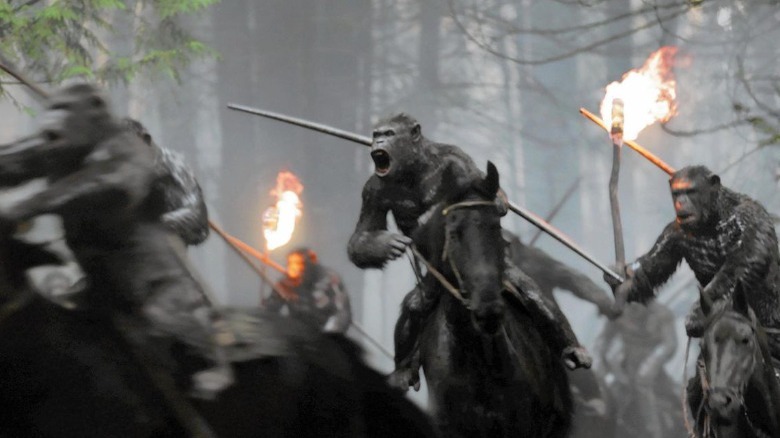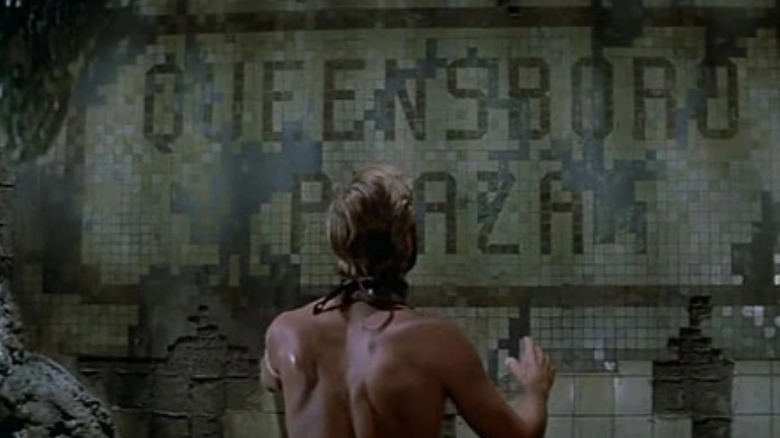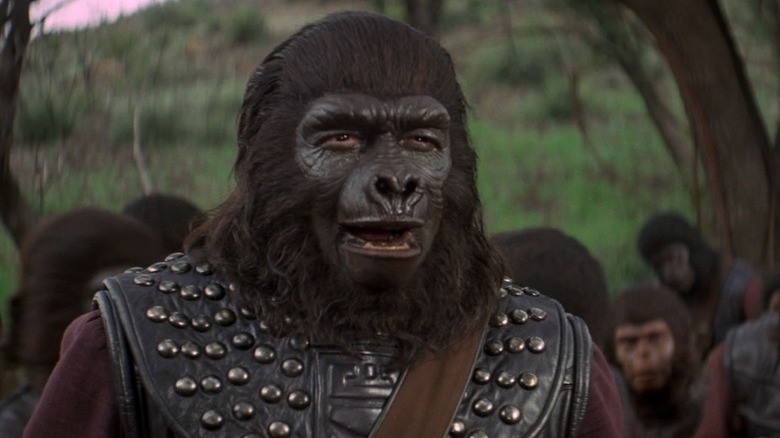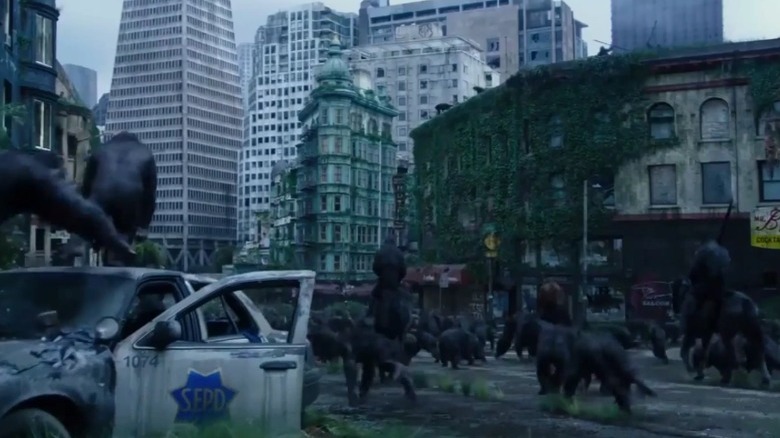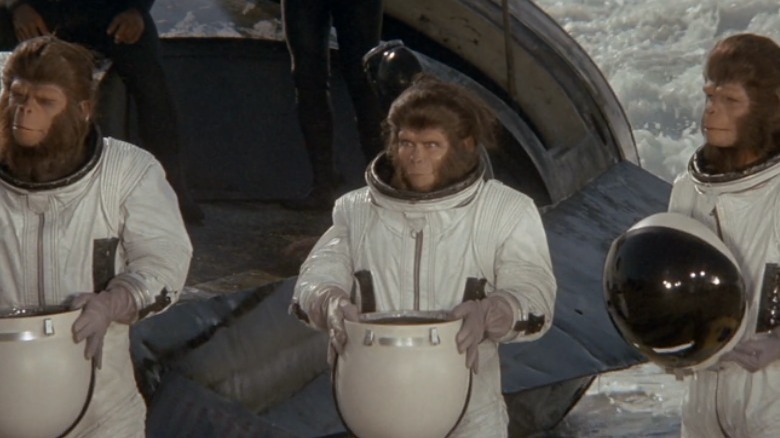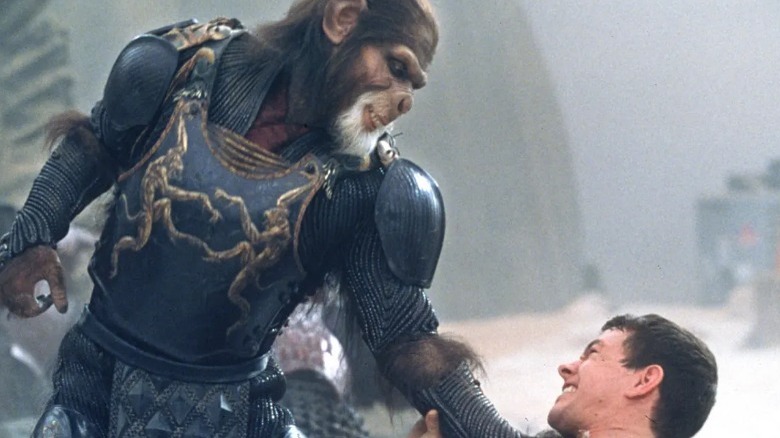The Most Pause-Worthy Moments From The Planet Of The Apes Franchise
Gone is the world of humanity, and from its ashes, a new world order arises as apes ascend to the highest form of intelligence on planet Earth. The original "Planet of the Apes," along with its sequels and reboots, have not only entertained audiences with thrilling stories, they've also waded into the existential study of a world wracked by calamitous change over centuries. The apes eventually show that their heightened intelligence only makes them a facsimile of humankind, often making the same mistakes socially and morally. As a human from 2,000 years in the past, Charlton Heston's space explorer George Taylor is instantly deemed inferior by the apes simply based on his race, even if he's clearly different from the feral humans of this future Earth who lack typical human intellect and attributes.
It seems that "Planet of the Apes" poses the idea that maybe humanity, itself, isn't the reason for our failings as a species. Perhaps, it's our intellect and sense of moral and authoritative superiority within the animal kingdom at large. The apes of this fictional world seem to ultimately tread the same path. The "Planet of the Apes" films, including the modern rebooted trilogy, never shy away from commenting on ethics and self-sustainability among an organized species. Perhaps that's what makes these films so powerful and timeless, with plenty of moments that still shock and amaze. Let's delve into those critical moments that may have you reaching for the pause button, or even a quick rewind.
The Statue of Liberty – Planet of the Apes (1968)
"A planet where apes evolved from men? There's got to be an answer," the intrepid George Taylor (Charlton Heston) remarks. The wise Dr. Zaius (Maurice Evans) retorts, "Don't look for it, Taylor. You may not like what you find." Indeed, the astronaut and man out of time does find the answer, and just as Dr. Zaius predicted, he doesn't like the result. After Taylor is freed by friendly apes, he and his mute human companion Nova (Linda Harrison) head for the Forbidden Zone, labeled as such by the ape civilization and off limits to all. The apes accompanying Taylor and Nova, Cornelius (Roddy McDowall) and Zira (Kim Hunter), desperately want to find answers to their own origins and whether a non-simian society existed before them. The Forbidden Zone can help provide those answers.
Zaius arrives with his soldiers, and issues the prophetic warning to Taylor before the latter receives the shock of his life. As Taylor and Nova ride along the shoreline on horseback, Taylor is shaken to his very core by what they find. All along, he had thought he was on some distant alien planet after having been in hypersleep for 2,000 years. But when he encounters the top of the Statue of Liberty jutting out of the sand, he realizes that he's been on Earth all along — an Earth that humanity ultimately ruined in a nuclear exchange, confirming his deepest fears about his own species.
Battle on the Golden Gate Bridge – Rise of the Planet of the Apes
"Rise of the Planet of the Apes" not only rebooted the franchise (again) in 2011, but it also traveled back in time to recount the events that led to apes eventually establishing their dominance over the human race. Dr. William Rodman (James Franco) is a skilled chemist who has been pioneering treatment of Alzheimer's disease. Ultimately, his treatment radically alters brain functions in the chimpanzees he tests, leading to the creation of Caesar, a baby ape birthed by one of Will's test subjects. Will and Caesar form a bond as the little primate begins learning at a rapid rate.
After an incident where Caesar acts in defense toward another person, he is placed in an ape shelter. Here he is mistreated heavily by Dodge Landon (Tom Felton), giving us all the more reason to hate Draco Malfoy. However, Caesar eventually stages an escape and also unleashes the experimental treatment on all of his fellow apes in lock-up. This leads to a revolt that depicts the apes attempting to flee authorities to safety across the Golden Gate Bridge.
This climactic moment near the end of the film depicts the first confrontation between humankind and apes who are becoming much more advanced intellectually. Many of these apes have also been subject to torment by humankind whether it was for experimentation or simple mistreatment by their caretakers. This fuels the aggression of the apes during the massive clash on the bridge, a spectacle that's shocking in its fury.
Praying to the bomb – Beneath the Planet of the Apes
The sequel to the original film, 1970's "Beneath the Planet of the Apes," takes viewers further into the Forbidden Zone. A new astronaut by the name of Brent (James Franciscus) crash-lands on Earth, part of a mission sent to search for Taylor's crew. Like Taylor before him, he knows he's traveled thousands of years into the future, but assumes he has arrived on another planet. He eventually meets Nova, who has seemingly lost Taylor under mysterious circumstances. The two eventually encounter an underground race of mutated humans with telepathic abilities who live in the ruins of New York City. They claim that their ancestors are the direct survivors of the nuclear holocaust that engulfed the world.
But despite their knowledge of the past, the mutants worship a giant nuclear weapon. And not just any weapon — this is the Alpha-Omega bomb, which can obliterate the entire Earth. This moment is shocking simply because of what we understand about humanity's demise. The imagery of a radiation-damaged doomsday cult worshipping the kind of device that obliterated their ancestors is worth hitting the pause button for a double-take. Of course, the bomb spells trouble for the planet once again: Taylor is mortally wounded and apparently thinks everything should just go up in smoke, so he ignites the bomb and destroys the planet. What a way to go out and simultaneously end a film, eh?
Koba kills two humans – Dawn of the Planet of the Apes
In the rebooted "Planet of the Apes" films of the 2010s, the simian known as Koba makes an interesting villain. Perhaps, calling him a villain is an oversimplification: Yes, he has bloodshed on the brain. He loathes humanity for what they've done to him and his kind over the years. This offers him an air of sympathy from audiences despite his violent nature. First and foremost, Koba is about putting his own kind first. He's one of those scheming actors who believes wholeheartedly that he's doing the right thing. In 2014's "Dawn of the Planet of the Apes," Koba unflinchingly opposes Caesar and his merciful attitudes towards humans because of the danger it can potentially bring to the rest of the apes.
Once the menacing primate gets his hands on firearms, all bets are off. Caesar nearly kills Koba for his attack on a human boy, but relents when he remembers that all apes follow a code: apes must not kill other apes. Still, Koba plots against Caesar and attempts to obtain guns from the humans. In one particular scene, he acts like an innocent chimpanzee to catch two soldiers off guard. He eventually snatches one of their M4A1 assault rifles and does tricks with it, pretending like it's a toy, to keep the two men mesmerized before quickly executing them. Koba smiling as he holds a gun to one of the soldiers' heads is a image that will be seared into the minds of viewers.
The final battle – War for the Planet of the Apes
Caesar's final struggle to free his family from hostility or oppression comes in "War for the Planet of the Apes" — except that he fights for all apes after his wife and child are killed by a human militia. In an homage to the bomb and mutant race in 1970's "Beneath the Planet of the Apes," the human milita in "War" is called Alpha-Omega. Like the bomb, these warring humans threaten to destroy everything the apes have established. Led by a vicious man known simply as the Colonel (Woody Harrelson), this paramilitary group considers itself humanity's last stand against total annihilation.
After Alpha-Omega captures several apes, Caesar and company embark on a potentially suicidal mission to free the captive primates. The apes, the militia, and the remnants of the U.S. Army engage in a clash at the climax, with the apes ultimately prevailing as Caesar triggers an avalanche to destroy the last remaining fighters on the ground. There's a couple of moments throughout the avalanche's destruction that are worth noting, including the entirety of Alpha-Omega being buried underneath the snow, followed by Caesar's view, safely perched in a tree, as he looks out over the landscape knowing that an entire army is buried underneath the snow.
Brent finds Queensboro Plaza – Beneath the Planet of the Apes
The original "Planet of the Apes" film series often does an expert job of making Earth feel otherworldly. In "Beneath the Planet of the Apes," astronaut Brent, like Taylor before him, doesn't realize that he's actually on his home planet. He surmises that this world of walking, talking apes can only be alien, as there's absolutely nothing familiar about the landscape. But then again, a lot can happen in two millennia.
Brent manages to find Nova, Taylor's original companion, and the pair flee from the apes into the Forbidden Zone. At one point they find a cave, which upon further exploration leads them to what Brent recognizes as the ruins of the Queensboro Plaza subway station in New York City. This is the moment that he realizes he has landed on a future Earth that has undergone an apocalyptic event centuries ago. While the audience already knows this thanks to the conclusion of the original film, it's still fun to pause and take note of the ruined subway station, as well as Brent's reaction to what can only be a mind-blowing, horrifying revelation. Later images — such as the destroyed Manhattan skyline poking out of the sand, or the mutants' mass in a ruined St. Patrick's Cathedral — don't have quite the same effect.
General Aldo murders Caesar's son – Battle for the Planet of the Apes
Those who have seen the more recent "Dawn" and "War" films might draw some parallels between those two films and "Battle for the Planet of the Apes," the fifth and final movie in the original cycle. "Battle" takes place shortly after humanity has withered following an apocalyptic nuclear war. Caesar (Roddy McDowall), the son of Cornelius and Zira from the original film, now attempts to lead the ape community and broker peace with the remaining humans. But a gorilla general named Aldo (Claude Akins) — one of the most prominent ape villains since Dr. Zaius — takes a hard line against humans and has a tendency for violent solutions. His rivalry with Caesar echoes the tension felt between Caesar and Koba in the rebooted films.
At one point, Caesar's son, Cornelius, eavesdrops on Aldo plotting with his fellow gorillas to stage a coup and take control. Unfortunately, the young ape is discovered. Aldo hacks at the tree branch Cornelius is perched upon, causing him to fall and become mortally wounded. The youngster later succumbs to his wounds. This moment, Aldo ruthlessly sending little Cornelius to his doom, is most shocking for diehard fans because Aldo commits the most egregious sin an ape can commit — the murder of another ape. It's poetic justice that Caesar later has his revenge by throwing Aldo off a tree to his death, but the ape leader feels only remorse at breaking his people's most sacred law as well.
The ruins of San Francisco – Dawn of the Planet of the Apes
There's something strikingly surreal about a post-apocalyptic landscape. We've seen them in film time and time again. Perhaps there's something serene and beautiful about vegetation reclaiming what was once humankind's domain. But there's also a simultaneously haunted feeling that takes hold as we realize that countless people have lost their lives in an incredibly planet-altering event. There's simply so much that can be conveyed with just one picture of an overgrown urban landscape that has fallen into decay and disrepair.
That's why the imagery of San Francisco desolate with overgrown foliage in "Dawn of the Planet of the Apes" is so striking. It's these images that cause us to pause and admire the detailed work that went into deconstructing a popular city we all know too well — a city seen as bustling and vibrant in the previous entry, "Rise." Now that the simian flu has spread throughout all corners of the world and much of humanity has perished in an extinction-level event, it's difficult to imagine the transformation of this metropolis that seemed so alive only a few years prior.
Ape astronauts – Escape from the Planet of the Apes
"Escape from the Planet of the Apes," the third film in the original series, kicks off with a doozy of an opening sequence. After the grim ending of its predecessor, "Beneath the Planet of the Apes," which resulted in the deaths of everyone on Earth, "Escape" depicts Cornelius, Zira, and Dr. Milo (Sal Mineo) arriving in the 20th century. We see them disembark on a beach from the spacecraft that belonged to Taylor, which was apparently catapulted back through time by the explosion of the planet at the end of "Beneath." The sequence is a twist on the previous two movies, which both opened on the rocky shores of the devastated future Earth and featured human astronauts.
As the military personnel line up to greet what they think are returning human astronauts on the shore where the ship landed, the officer welcoming them back to the United States is shocked when they remove their helmets to reveal humanoid apes. It's a truly surprising image that might even shock moviegoers who have no idea where the plot is headed. How did the apes get to our time? What will humanity make of them? Cornelius and Zira now have the opportunity to witness the pre-ape human civilization they once avidly sought evidence of, and they may not like what they find.
The villainous General Thade – Planet of the Apes (2001)
The first reboot of "Planet of the Apes" didn't quite take off with fans and critics (via Rotten Tomatoes) like it was intended to, resulting in a one-and-done adventure. Director Tim Burton helmed the 2001 action thriller, which starred Mark Wahlberg as Captain Leo Davidson, the wayward astronaut filling the role of Charlton Heston's George Taylor from the original. The inimitable Tim Roth portrays the film's biggest villain, General Thade. While fans of the franchise were likely disappointed with this reboot, Thade has been recognized as one of the film's high points.
Thade is frightening and lights up the screen at almost every turn. His savagery is even inflicted on his own kind, as he beats his own apes with impunity for any dereliction of duty under his command. One such moment involves two bullish apes who inform General Thade of a crashed spacecraft. It's this moment that truly solidifies how evil Thade really is. After thanking them for the information, he brutally beats and kills them to ensure he is the only one with the knowledge of the spacecraft. What's glaringly difficult to comprehend is that these two gorillas are bigger than Thade, a chimpanzee, yet he takes them out simultaneously. In the end, Thade wants to take control of the ape population. He's a fascinating villain who creates multiple opportunities for other pause-worthy moments throughout his brutal campaign.
